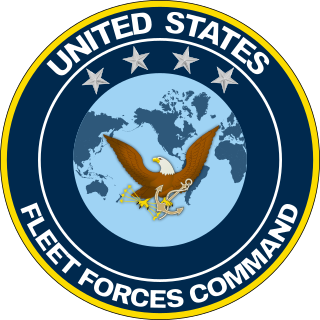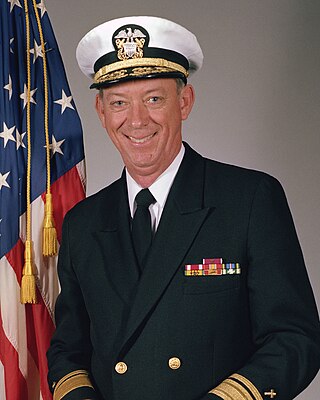
Arthur LeRoy Bristol, Jr. was a vice admiral in the United States Navy, who held important commands during World War I and World War II, and was an early aircraft carrier commander.

The United States Fleet Forces Command (USFF) is a service component command of the United States Navy that provides naval forces to a wide variety of U.S. forces. The naval resources may be allocated to Combatant Commanders such as United States Northern Command (USNORTHCOM) under the authority of the Secretary of Defense. Originally formed as United States Atlantic Fleet (USLANTFLT) in 1906, it has been an integral part of the defense of the United States of America since the early 20th century. In 2002, the Fleet comprised over 118,000 Navy and Marine Corps personnel serving on 186 ships and in 1,300 aircraft, with an area of responsibility ranging over most of the Atlantic Ocean from the North Pole to the South Pole, the Caribbean Sea, Gulf of Mexico, and the waters of the Pacific Ocean along the coasts of Central and South America.

William Harrison Standley was an admiral in the United States Navy, who served as Chief of Naval Operations from 1933 to 1937. He also served as the U.S. ambassador to the Soviet Union from 1941 until 1943.

John Henry Towers CBE was a highly decorated United States Navy four-star admiral and pioneer naval aviator. He made important contributions to the technical and organizational development of naval aviation from its beginnings, eventually serving as Chief of the Bureau of Aeronautics (1939–1942). He commanded carrier task forces during World War II, and retired in December 1947. He and Marc Mitscher were the only early Naval Aviation pioneers to survive the hazards of early flight to remain with naval aviation throughout their careers. Towers spent his last years supporting aeronautical research and advising the aviation industry.

George Snavely Rentz was a United States Navy chaplain who served during World War I and World War II. For selfless heroism following the loss of USS Houston (CA-30) in the Battle of Sunda Strait, he was posthumously awarded the Navy Cross— the only Navy Chaplain to be so honored during World War II.

William Banks Caperton was an admiral of the United States Navy. He held major posts ashore and afloat, chief of which were commanding the naval forces intervening in Haiti (1915–16) and Santo Domingo (1916), and Commander-in-Chief, Pacific Fleet, from July 28, 1916, to April 30, 1919. He served actively until November 12, 1921.

Vice Admiral David Charles Nichols Jr. is a retired senior U.S. Navy officer and Naval Flight Officer. At the time of his retirement in September 2007, he was the Deputy Commander of United States Central Command (USCENTCOM) at MacDill AFB, Florida.

Roy Lee Johnson was a highly decorated four-star Admiral in the United States Navy. A Naval Academy graduate, he trained as Naval aviator and distinguished himself as Air Group Commander during several World War II campaigns.

Rear Admiral Gilbert Jonathan Rowcliff was an officer of the United States Navy during the First World War and the Second World War. After early service in the Far East, he specialised in gunnery, serving in that capacity on many US Navy capital ships. During World War I he served with the US Naval Force sent to join the British Grand Fleet.

Patrick Nieson Lynch Bellinger CBE was a highly decorated officer in the United States Navy with the rank of Vice Admiral. A Naval aviator and a naval aviation pioneer, he participated in the Trans-Atlantic flight from Newfoundland to Azores in May 1919 and was decorated with Navy Cross, the United States military's second-highest decoration awarded for valor.

Herbert Fairfax Leary was a highly decorated officer in the United States Navy with the rank of vice admiral. A son of Rear Admiral Richard P. Leary, he distinguished himself during World War I while on the staff of commander, U.S. Naval Forces in Europe under Admiral William Sims and received the Navy Cross, the United States Navy's second-highest decoration awarded for valor in combat.
John Francis "Jake" Laboon Jr. was an officer of the United States Navy, who served as a submariner in World War II and as a Roman Catholic chaplain in the Vietnam War.

Mark Luzerne Tidd is a former United States Navy officer who served as the 25th Chief of Chaplains of the United States Navy from 2010 to 2014.

Herbert Douglas Riley was a highly decorated officer in the United States Navy with the rank of Vice admiral. A United States Naval Academy graduate, he trained as naval aviator and distinguished himself first as commanding officer of the escort carrier USS Makassar Strait during the combats at Iwo Jima and Okinawa during World War II.

Anderson Byron Holderby Jr. was a rear admiral and Chief of Chaplains of the United States Navy.

Neil MacGill Stevenson was a rear admiral and Chief of Chaplains of the United States Navy.

Ross Henry Trower was a rear admiral and Chief of Chaplains of the United States Navy.

William Nathaniel Thomas was a US Navy chief of chaplains, described by one historian as "one of the most distinguished Chaplains ever to serve in the US Navy." Born in Mississippi and entering the navy in 1918, he became a rear admiral and was a chief of chaplains of the United States Navy (1945–1949). He was chaplain aboard the USS Madawaska, a World War I troop transport. He then served on the USS Pennsylvania, the USS Raleigh and the USS West Virginia. He served at the United States Naval Academy in Annapolis, Maryland, as an assistant chaplain and then as command chaplain. He wrote the Prayer of the Midshipman and the Dedication in Memorial Hall at the Naval Academy.

Francis Stuart Low CBE was a decorated officer of the United States Navy with the rank of four-star admiral. An expert in submarine warfare, Low is credited with the idea that twin-engined Army bombers could be launched from an aircraft carrier. This idea was later adopted for the planning of the Doolittle Raid.

John Jennings Ballentine was an early United States Naval Aviator who commanded the escort carrier USS Long Island and the fleet carrier USS Bunker Hill during World War II. After the war, he commanded the United States Sixth Fleet and Naval Air Force Atlantic.



















